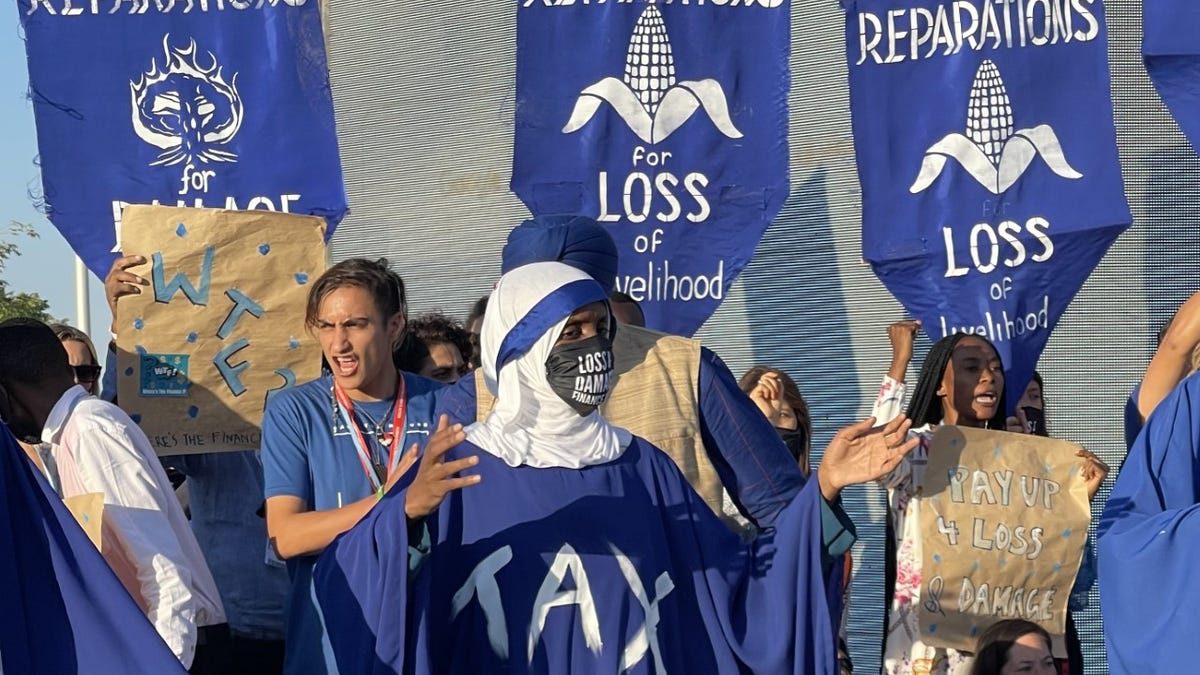
Protesters are asking for reparations for loss and damage.
Katie Collins/CNET
![]()
This story is part of CNET Zero, a series that chronicles the impact of climate change and explores what’s being done about the problem.
President Biden arrived at the UN’s COP27 climate summit in Egypt on Friday with a message for the world about the US’ role as a climate leader, and about its 2022 climate achievements — namely, the passing of the Inflation Reduction Act, which includes provisions committing hundreds of billions of dollars to address climate change.
But after stepping off his overnight flight and strolling between meetings in the glow of the desert golden hour, it turned out the world had a message for him: “Pay up! Pay up! Pay up for loss and damage!” chanted protesters as his security detail hurried him past.
A protest involving at least 50 people, some dressed in blue robes and holding placards asking for “reparations,” was already well underway when Biden and his entourage, which included Speaker of the House Nancy Pelosi and other members of the US congressional delegation, passed by.
After several warmup chants, Harjeet Singh, senior adviser at Climate Action Network International, was just beginning to tell the crowd about the importance of loss and damage — compensation for the victims of the climate crisis in vulnerable countries, paid for by those who did most to cause it. Loss and damage a key issue for climate justice activists and has finally has recognition on the official COP27 agenda this year after over 30 years of campaigning. Singh has been central to this campaigning, but he paused his speech when alerted to the fact that the leaders of the country with the highest historical emissions just happened to be walking past, not even 50 meters away.
The crowd of protesters turned on Biden and began to chant again, louder and more ferociously this time. For many of the activists there from across Africa and the developing world, it might be their only opportunity to emphasize to the leader of the US their feelings about his country’s reluctance to pay them compensation for the loss of life, land, livelihoods and culture they’ve experienced as a result of human-made climate change. Overhead, private planes prepared to land at Sharm-el-Sheikh Airport while the American lawmakers scurried away, making no visible attempt to acknowledge the protesters. The scene painted a picture of worlds colliding.
After Biden’s entourage had passed, Singh resumed his speech. “It was important to send a message to the US administration,” he said. “The US is the biggest historical emitter and the biggest blocker on the issue of loss and damage finance for the last 30 years.”
The US has historically opposed tackling loss and damage at climate talks, fearing the liability it would face. At COP27, the country has changed its tune, acknowledging the importance of establishing loss and damage financing. For the past few days, John Kerry, Biden’s climate envoy, and other lawmakers and officials have talked up the US’ willingness to play its part in helping the world’s most vulnerable. Kerry said that the US will do its bit, but has also talked about shifting the responsibility to the private sector, leaving many suspicious that the country is not serious.
“There is some movement, that’s why we got it on the agenda,” said Singh. “But you know what is happening right now in the negotiating rooms? They’re only paying lip service.”
The COP27 agenda specifies that a loss and damage financing facility should be established by 2024, but many are hoping that it could instead be achieved over the course of this summit. Those advocating for loss and damage financing argue that there is no time to waste — people are being impacted by the climate crisis right now.
“Ordinary people are suffering,” said Singh. “From this action we’re sending a very strong message to all the countries and particularly the blockers that you have to be constructive. You have to change course and you have to agree on the loss and damage finance facility here.”
The protest ended peacefully, with activists swaying together to music calling out “industrialization from the rich nations,” reparation banners dancing and twirling in the early evening breeze.
